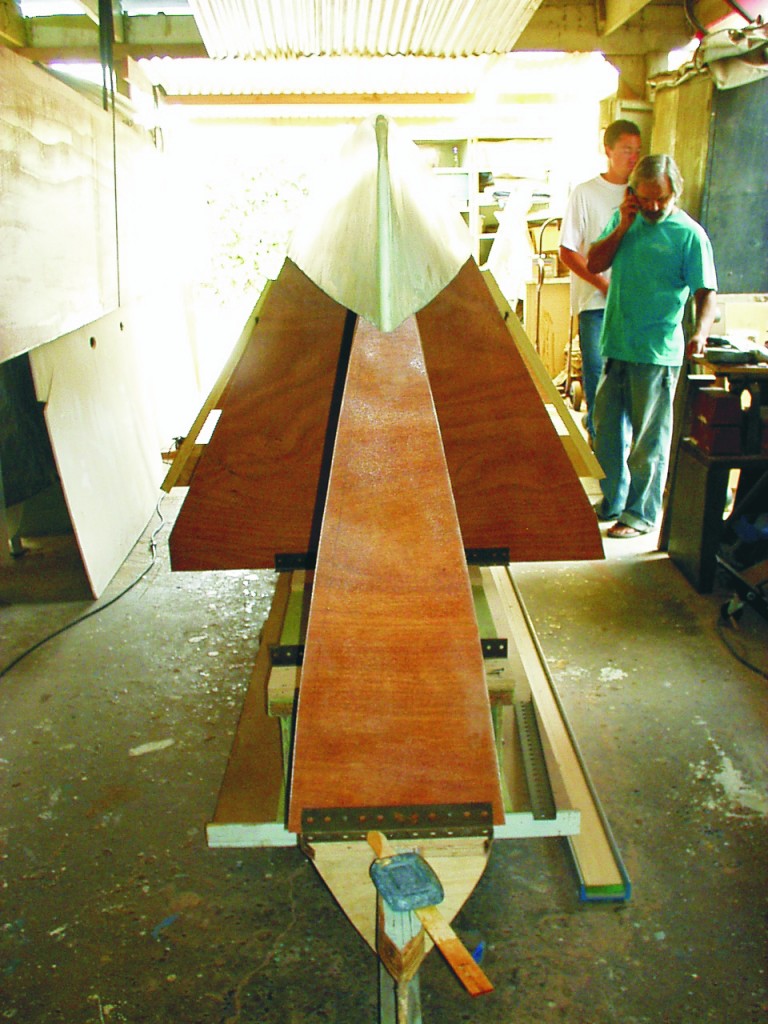
A folding trimaran for DIY boat builders
by Michael Leneman, Multi Marine
Above: A completed L-37 multihull at the dock. Multi-Marine’s new 23′ folding trimaran kit features manufactured hull pans. The builder attaches plywood topsides to the pans.
What is the simplest way for a home builder to build a good, light hull for a catamaran or trimaran? A few years ago, we set about looking for an inexpensive way to construct a small trimaran that we had developed as a prototype. The answer we came up with was unique: to combine a fiberglass molded “pan” with plywood/glass/epoxy topsides.
It is very time-consuming to build and fair the three hulls of a trimaran. So our concept was to make the exacting, complex curved, below waterline shape of the hull—the pan—in a mold. The simpler, above waterline shape can then be formed in easy-to-make plywood/ composite panels. This combination results in lightweight hulls, which are easy to build. The plywood/composite panels bend to a nice, fair curve so that almost no laborious fairing is required. The pre-molded fiberglass/ epoxy pan is, of course, already fair.
From this concept, Multi Marine’s new 23′ folding trimaran, the L-7, emerged (See image at top). The home builder can purchase pre-manufactured fiberglass/epoxy-molded pans for the main hull and floats from Multi Marine and then join these to plywood/glass/epoxy topsides he or she builds. (The full kit includes the fiberglass/epoxy pans for the main hull and floats, the glass-pultruded I-beams (tapered), pultruded “C” channel for the x-arm boxes and daggerboard, mast kit, rigging, sails, plywood, fiberglass, and foam. WEST SYSTEM® epoxy, rollers, squeegees, and other accessories can be bought from a local dealer or West System, Inc. The full kit costs less than $19,000, including a mainsail and jib. Any item may be purchased separately.
The floats (amas)
For the floats, the builder starts upside down with the deck and then installs trapezoid-shaped, “picture-frame” bulkheads. The okoume marine plywood topsides, which have already been fiberglassed on the inside, are then installed (Figure 2). Next, the butt blocks are put in and the fiberglass pan is epoxied in place (Figure 3). Once that is done, the whole outside of the hull is fiberglassed. An amateur builder can make this float in less than 40 hours. We have built 6 floats like this, and there is virtually no fairing, just some microballoon passes where there is a joint.


The main hull
The main hull (if you’re building a trimaran) is done a bit differently. The full bulkheads for the main hull are built first and placed on a strongback. Then the fiberglass pan is glued to the bulkheads (Figure 4). The butt blocks are glued to the pan (not the topsides, as in the floats). Lastly, the topsides are put on. After everything is set, the builder turns the hull right side up, levels the sheer, and puts on the decks and cabin. The cockpit floor, decks, anchor locker floor, cabin side seats, and lazarette floor are all flat and are pre-made with foam, glass, and plywood. There is basically an entire mid-height sheer web that runs through the entire main hull.

For the main hull decks, cockpit floor, anchor locker floor, and seats, we use a combination of thin plywood, styrene foam, and glass. High-density styrene foam is not usually used in custom boat construction because polyester resin eats the foam, and styrene foam is susceptible to pressure dings. However, WEST SYSTEM Epoxy works great with styrene foam, and bonding a thin layer of plywood to the top face of the composite panels eliminates the pressure ding problem. A composite panel made this way (ply-styrene foam-glass) is very stiff and light. The best part is that the cost is about 1/3 that of a standard urethane foam-cored, glass composite panel.
The X-arms
The X-arms are one of the coolest parts we came up with. They are fiberglass pultruded I-beams. The best part is that you can cut the sheer web of the beams and bend the caps down to make a nice looking, tapered, outside shape to the beam. The beams look good, they are pre-made, they can’t corrode, they are strong, you can paint them any color you want, and they are inexpensive.
Rigging and sails
To fill out the rest of the basic boat, we extruded our own mast and designed our own rigging with the added feature of a roller-furling boom. Full-batten mainsails lend themselves to being furled around the boom, especially since we use an inexpensive round aluminum tube as our boom. With a main, jib, and reacher, the boat is about the same speed around the racecourse as a stock F-31 folding trimaran with a full inventory of sails.
The Eko-Cat 23
So, now you’re sitting around looking at the trimaran floats, and you say to yourself, “gee, those would make nice catamaran hulls if they just had a little more freeboard in the transom.” Well, this can be easily done since the topsides of the floats can be changed in a second. It is only the pan/topside joint that has to remain the same. We have made a few small power catamarans from old beach cats, so making the power Eko-Cat 23 from these hulls turned out to be very easy. The mileage is incredible. An 8-hp motor makes 12 knots and over 20 miles per gallon in flat water. With a 25-hp motor, the boat does 20 knots.

L-7 Folding Trimaran Specifications
Length: 23′ 6″
Beam: 16′ 6″
Folded beam: 8′ 4″
Mast height: 33′
Sail area (main & jib): 370 sq ft
Weight (empty): 1300 lb
For more information on both of these projects, visit Multi Marine.





